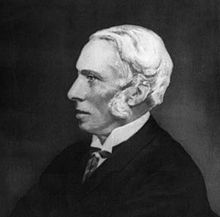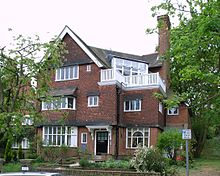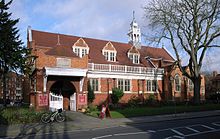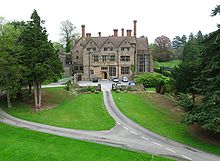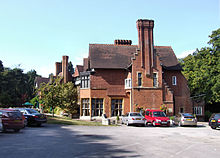- Richard Norman Shaw
-
Richard Norman Shaw RA (Edinburgh,Scotland, 7 May 1831 – London,England, 17 November 1912), was an influential Scottish architect from the 1870s to the 1900s, known for his country houses and for commercial buildings.
Contents
Life
Shaw trained in the London office of William Burn with George Edmund Street and attended the Royal Academy classes, receiving a thorough grounding in classicism, and met William Eden Nesfield, with whom he was briefly in partnership. In 1854 – 1856 he travelled with a Royal Academy scholarship, collecting sketches that were published as Architectural Sketches from the Continent, 1858.
In 1863, after sixteen years of training, he opened a practice for a short time with Nesfield. In 1872, Shaw was elected an Associate of the Royal Academy.
He worked, among others, for the artists John Callcott Horsley and George Henry Boughton, and the industrialist Lord Armstrong. He designed large houses such as Cragside and Grim's Dyke, as well as a series of commercial buildings in a wide range of styles.
Shaw was elected to the Royal Academy in 1877, and co-edited (with Sir Thomas Jackson RA) the 1892 collection of essays, Architecture, a profession or an Art?.[1] He firmly believed it was an art. In later years, Shaw moved to a heavier classical style which influenced the emerging Edwardian Classicism of the early 20th century. Shaw died in London, where he had designed residential buildings in areas such as Pont Street, and public buildings such as New Scotland Yard.
His picturesque early country houses avoided the current Neo-Gothic and the academic styles, reviving vernacular materials like half timber and hanging tiles, with projecting gables and tall massive chimneys with "inglenooks" for warm seating. The result was free and fresh, not slavishly imitating his Jacobean and vernacular models, yet warmly familiar, a parallel to the Arts and Crafts movement. Richard Norman Shaw's houses soon attracted the misnomer the "Queen Anne style". As his powers developed, he dropped some of the mannered detailing, his buildings gained in dignity, and acquired an air of serenity and a quiet homely charm which were less conspicuous in his earlier works; half timber construction was more sparingly used, and finally disappeared entirely.
His work is characterised by ingenious open planning, the Great Hall or "sitting hall" with a staircase running up the side that became familiar in mass-produced housing of the 1890s.
He was also involved in ecclesiastical architecture. He restored St. John's Church, Leeds and designed new churches such as St. Margaret's, Ilkley, All Saints', Leek and All Saints', Richards Castle.
Built work
 Cragside, Northumberland
Cragside, Northumberland
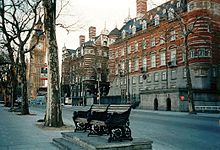 Norman Shaw Buildings, London
Norman Shaw Buildings, London
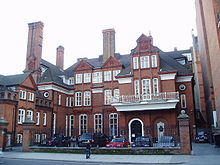 Lowther Lodge, headquarters of the Royal Geographical Society
Lowther Lodge, headquarters of the Royal Geographical Society Grim's Dyke, Harrow, London
Grim's Dyke, Harrow, London
- 1-2 St James St, London, 1882
- Glen Andred, at Withyham,Sussex, 1867
- Leyswood, at Withyham,Sussex, 1866–1869
- Cragside, at Rothbury, Northumberland, 1869/1870–1885
- Preen Manor, Shropshire
- Grim's Dyke, Harrow, London, 1870
- New Zealand Chambers, Leadenhall Street, London, c. 1870–80
- Pierrepont and Merrist Wood, Surrey
- Lowther Lodge, Kensington, 1873–1875, headquarters of the Royal Geographical Society
- 6 Ellerdale Road, Hampstead, London, built for himself
- House of Bethany, St Clement's Road, Bournemouth, Dorset, 1874–1875
- Wispers, West Sussex, 1874-1876
- Pierrepont House, Frensham, 1876–78
- Old Swan House, 17 Chelsea Embankment, London, 1875–1877
- Bedford Park, London, the first "garden city" suburban development: housing, including St Michael and All Angels Church, 1879–1882
- Albert Hall Mansions, at Kensington Gore, London, 1879–1886
- Adcote, Little Ness, Shropshire, 1876–1881
- Flete House, Devonshire
- Greenham Lodge, Berkshire
- Dawpool, Cheshire (demolished, 1920s)
- Bryanston School, Dorset
- Chesters, Northumberland
- New Scotland Yard, on the Thames Embankment, London, 1887–1906 (built as the headquarters of the Metropolitan Police, now known as the Norman Shaw Buildings and used as Parliamentary offices)
- Piccadilly Hotel, Piccadilly Circus, London, England, 1905 to 1908; his last work
- Albion House, James Street, Liverpool, 1896–1898
- House for Kate Greenaway, Frognal, London, 1885
- Swanscombe Church in Kent
- White Lodge and White Lodge West, Bingley, West Yorkshire
- Bannow, Residential Care Home, St Leonards-on-Sea, East Sussex, 1877
- Claremont School, originally the Ebden family home named Baldslow Place, St.Leonards-on-Sea, East Sussex 1888
- 4 - 6 Page Heath Lane, Bickley, Kent, 1864
- The Corner House, 114 Shortlands Road, Beckenham, Kent, 1869
- 88 St. James's Street, London, 1904
- Bailiff's Cottage, Bromley Palace Estate, Bromley, Kent, 1864 (demolished)
- Town Hall, Market Square, Bromley, kent, 1863 (unexecuted)
- Bradford City Hall extension 1909.
- Holy Trinity Church, Bingley, Yorkshire 1866-1868 (demolished 1974)
- Holme Grange School, Wokingham, Berkshire East Sussex 1883
- Alderbrook Park, Cranleigh, Surrey 1881 (house for Pandeli Ralli, demolished 1956)
- Flora Fountain, Mumbai, India, 1864
- Highdown School, Emmer Green, Reading, Berkshire, 1878-80
Other work
- ^ Richard Norman Shaw, editor: Architecture: A profession or an art: thirteen short essays on the qualifications and training of architects, London, Murray, 1892. Contributors include: R. Norman Shaw, J.T. Micklethwaite, Reginald Blomfield, G.F. Bodley, Mervyn Macartney, Ernest Newton, Edward S. Prior, John R. Clayton, Basil Champneys, W.R. Lethaby, W.B. Richmond, Gerald Horsley and T.G. Jackson.
External links
- Great Buildings on-line: Richard Norman Shaw
- Illustrations of Adcote
- Flickr photoset
 "Shaw, Richard Norman". Encyclopædia Britannica (11th ed.). 1911.
"Shaw, Richard Norman". Encyclopædia Britannica (11th ed.). 1911.
References
- Andrew Saint, Richard Norman Shaw, revised edition, 2010. ISBN 978-0-300-15526-6.
Categories:- British architects
- 1831 births
- 1912 deaths
- People from Edinburgh
- Royal Academicians
- English ecclesiastical architects
Wikimedia Foundation. 2010.

